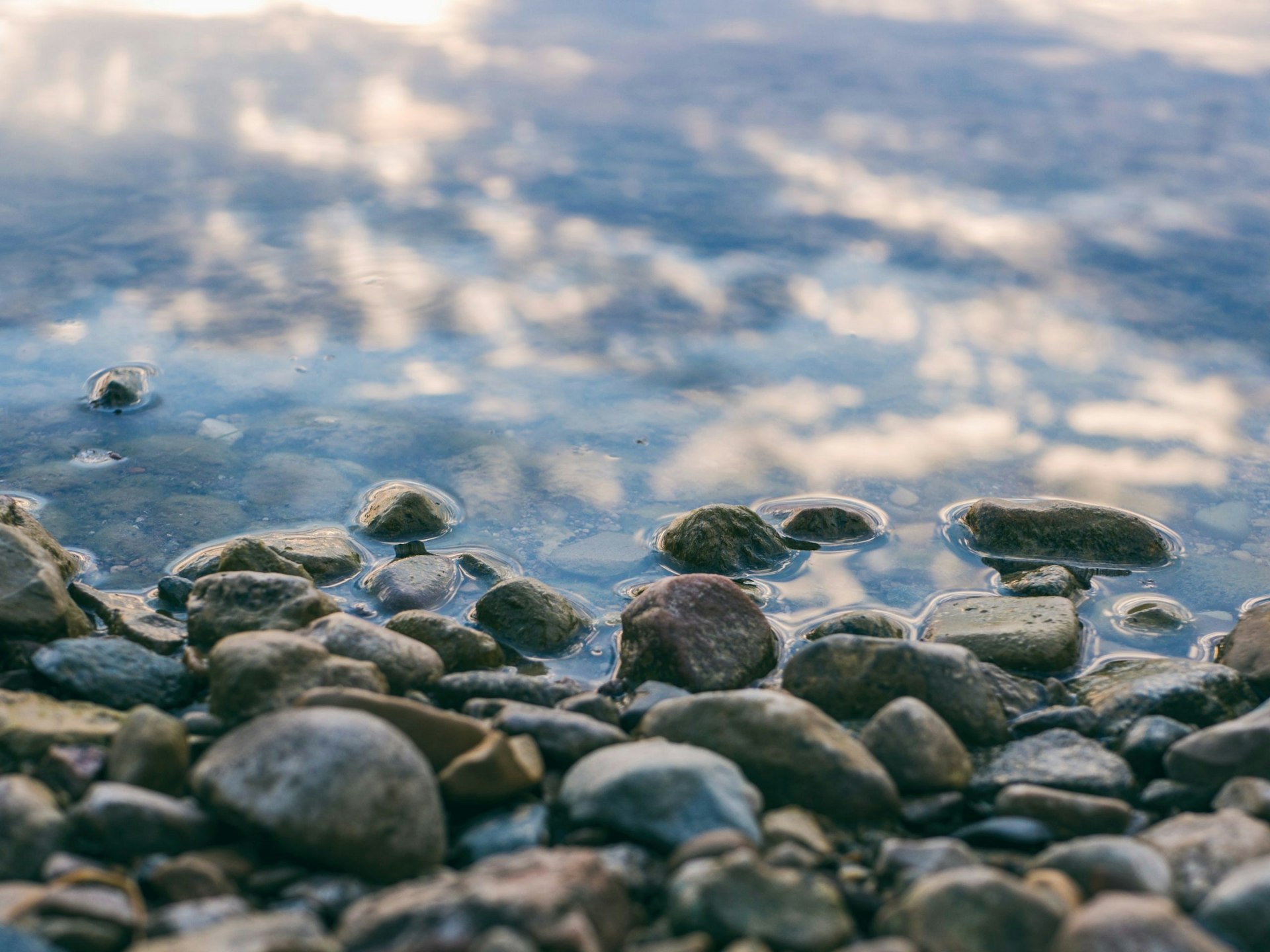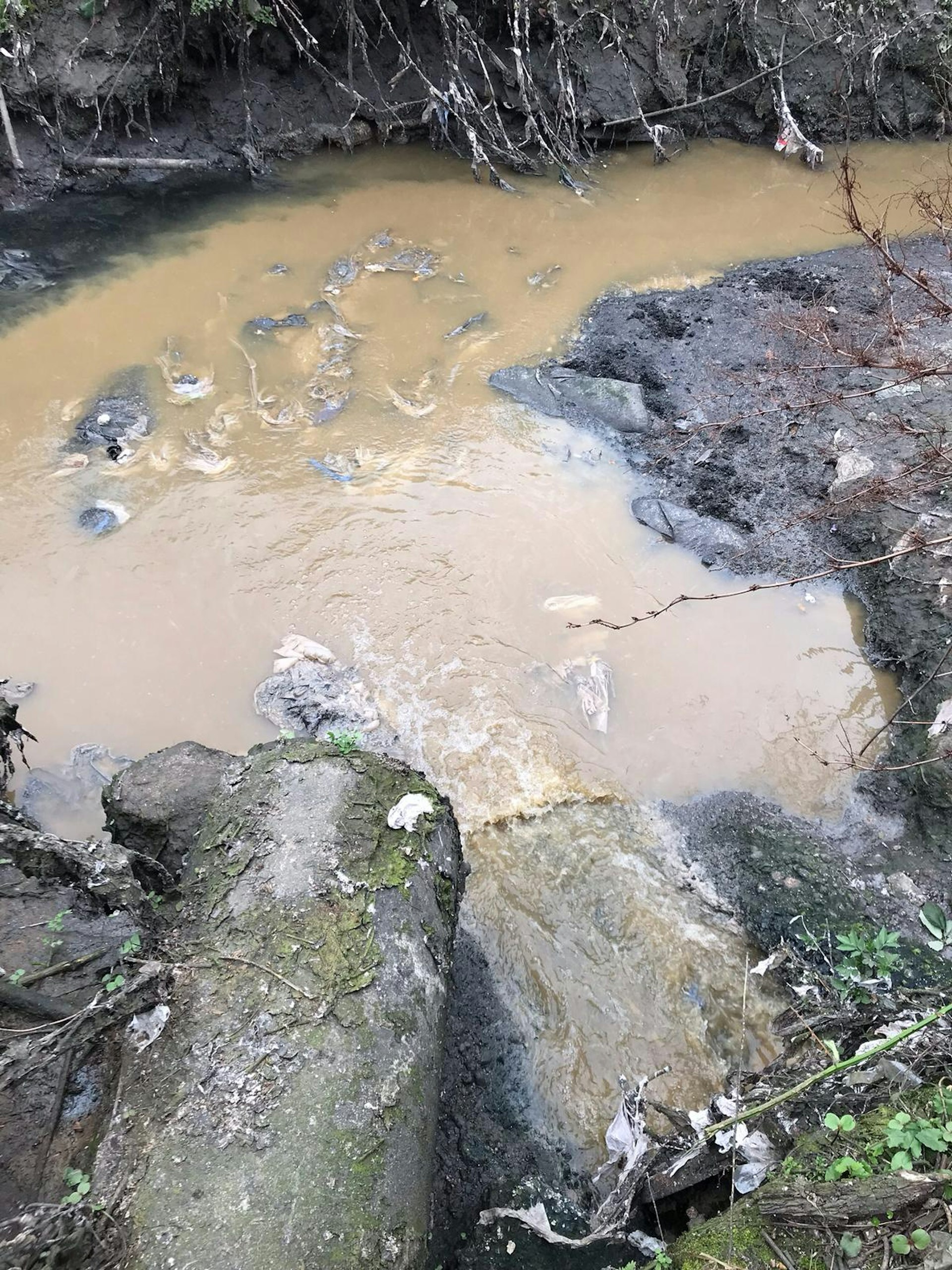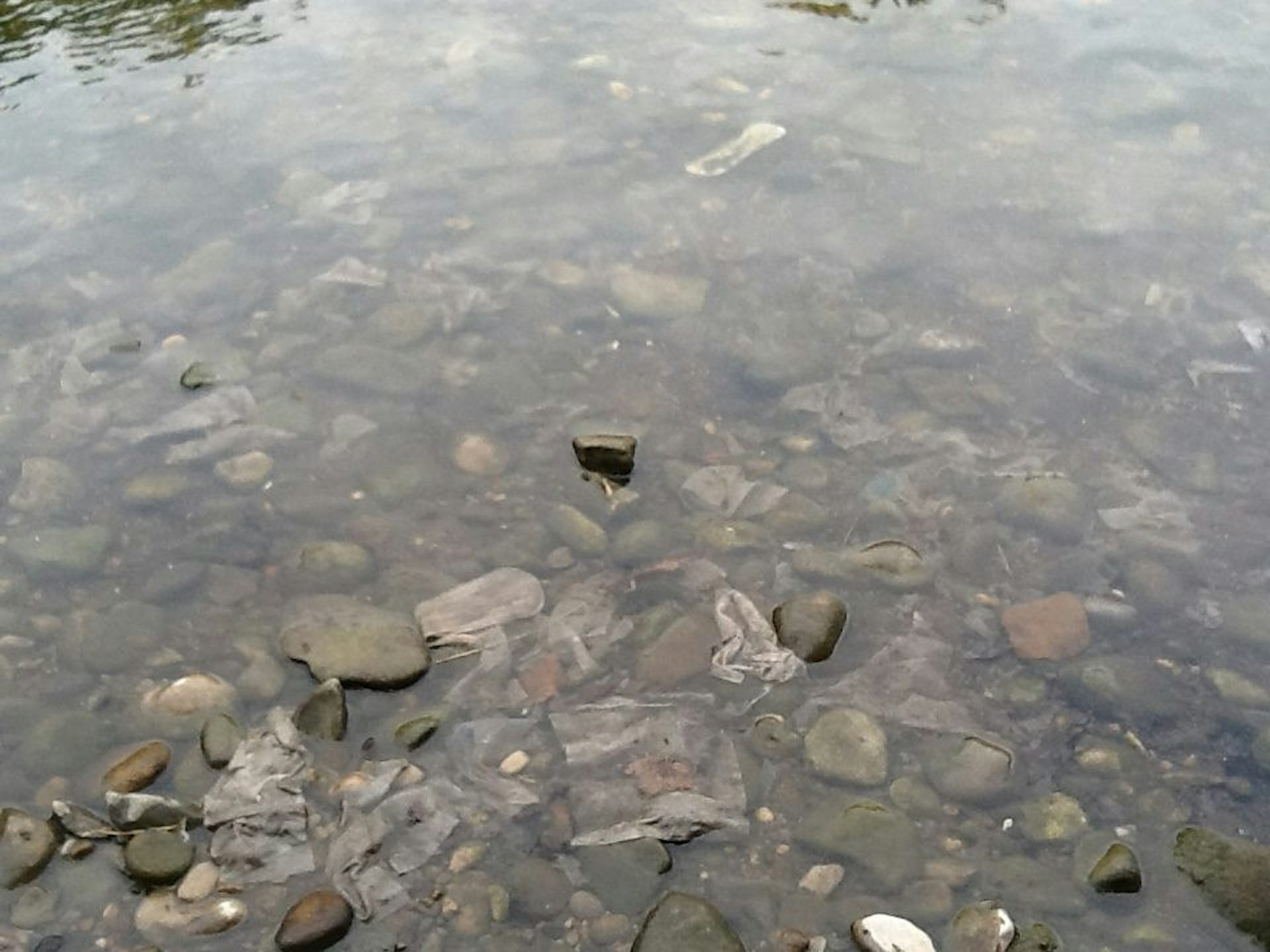
‘It’s absolutely horrific’: Inside Britain’s sewage crisis
- Text by Andrew Kersley
- Photography by Ian Cylkowski
Down a five foot concrete drop and across metres of overgrown river bank there’s a small concrete outlet surrounded by barbed wire. Hidden away behind a Nissan dealership surrounded by grey motorways and ’60s tower blocks, this stream and its tiny concrete outcrop spewing liquid are very easy to miss.
This is an illegal sewage pipe, dumping the toilet paper, condoms, wet wipes and faeces flushed down the toilets of East London into the River Roding. The 50km river, London’s third biggest and a major tributary of the Thames, meets Alders Brook, the small stream the outlet is on, near the centre of Ilford.
Paul Powesland, a 35-year-old lawyer, only found the outlet by accident while leading a riverside cleanup for the a local group of activists called the River Roding Trust. While they didn’t have any testing equipment themselves, they could tell the liquid flowing out was sewage just from the smell, and the collection of baby wipes and toilet paper plastered to the river bank. Even now, as he leads me to the outlet, the tell-tale signs are all there: plastics, tissues and sewage fungus, a grey plant that rapidly spreads in water with high levels of human waste. He gestures towards the dark banks as he tells me that what resembles wet riverbank mud is actually a slurry of water, dirt and faeces from the raw sewage being pumped into the stream.
Over the last few weeks, the debate around the dumping of raw sewage by water companies into the UK’s rivers and seas has been the subject of significant public attention. The problem centres on Combined Sewer Overflows, or CSOs, which are river outflows on mixed pipes of rainwater and raw sewage that are supposed to be used when unprecedented rainfall causes pipes to overflow before they can reach treatment plants. Struggling to deal with the amount of sewage and rainfall in their severely outdated infrastructure though, the private companies that manage the UK’s water have been increasingly relying on CSOs to dump raw sewage into rivers on a regular basis. There were 403,171 sewage dumps into England’s rivers and seas in 2020 – over three million hours of spillages. While the government has U-turned and promised to solve the problem, they’re still refusing to support an amendment that would have placed a legal duty on water companies not to pump waste into rivers.

River Roding
In East London, the problem is slightly different from CSOs: the outlet is supposed to just be for removing rainwater, but when the nearby sewage pipe gets blocked it overflows into this outlet – something which is illegal. Powesland tells me that the outlet can release hundreds or even thousands of litres a day and can leak sewage for days or even weeks without Thames Water checking on it. The outlet, and others like it, often don’t even get physically recorded in the CSO data used by campaigners either.
A spokesperson for Thames Water claimed that they were carrying out daily and weekly inspections of the outfall and brook as well as eventually installing 24-hour monitoring equipment at the outfall. They also said a major cause of the problem was takeaways wrongly disposing of fat and oil in the drains.
The spokesperson added: “Fixing this will be complex, but our engineering teams are looking into various designs to provide a long-term solution to the problem.
“To combat blockages, we’ve increased the frequency of sewer cleaning along Romford Road, and we’re working with several food premises in the area to help stop cooking fat, oil and grease getting into the sewer in the first place.”
Powesland first came to the Roding five years ago on his houseboat with plans to restore the river. He later founded the River Roding Trust and attracted other boaters to come and live on this stretch of the river and help to clean it up. They all contribute a set number of hours a month to cleaning the river they live on.
But for the last few years, the group often feel like they’ve been fighting an uphill struggle. “We’ve had meetings with the Environment Agency (EA) and Thames Water,” Powesland tells me as we navigate our way back through the undergrowth. “But it’s been a mixture of them trying to kind of appease us by saying, ‘Yes, we’ll do something’. But then there is no evidence that it is actually really being done.” He tells me that while Thames Water have admitted the problem exists, they have largely refused to set up any kind of monitoring system for how frequently sewage seeps into the river. According to Powesland, their excuses have included being unable to access the outlet, health and safety concerns for walking near the stream and even the presence of Japanese knotweed.
“If I took five litres of the stuff that’s flowing out of there and threw it over the Thames Water HQ the police would nick me and put me in a cell, but Thames Water can put millions of times that amount into the environment and at best they might get a fine that amounts to 0.01 per cent of their profits,” he tells me, angrily. “It’s the way our society treats the criminality of corporations; if you do it on a massive scale they basically get away with it.”
Similar problems are occurring elsewhere, such as in Staveley, Cumbria. With its ancient churches and 19th-century stone houses, the area could be the quintessential Lake District village. But now, its residents are afraid every time it rains that their streets may flood with sewage. Manhole covers across the town regularly flood during heavy downpours, forcing residents to wade through toxic water to leave their homes or visit shops on a regular basis. Since 2015, there have been 61 instances of significant raw sewage overflow into the village – an average of almost once a month.
Beyond the village itself, the sewage is being dumped into the area’s two rivers: the Kent and the Gowan. “It’s not hard to find people who have seen with their own eyes the dead fish floating the river,” Isobel Stoddart tells me, the chair of local campaign group Sustainable Staveley.
The local water company United Utilities has said it can’t afford to fix its failing infrastructure in the area. “They say it is just too expensive… that it will cost about 1.5 million to rectify the situation,” says Stoddart. “But then how is this infrastructure being allowed to get into this situation in the first place? And how much money has been paid out in shareholder dividends over the years since the water companies were privatised?”
Meanwhile, the EA has done little to nothing to intervene in the village – only recently beginning a preliminary investigation into mass species death in nearby rivers. Frustration at the inadequacy of the EA is shared by all the campaigners Huck spoke to, but it’s hardly surprising. Since 2010, the government agency in charge of protecting the environment and stopping pollution and floods has been on the receiving end of brutal austerity, seeing its budget slashed by nearly two thirds from £120m to just £48m. In 2013, the service had to fire 1,700 staff, or 15 per cent of its workforce to keep afloat. The chair of the EA recently warned the government that their cuts to the service had left them unable to fully function. The EA did not respond to Huck’s request for comment.
Those cuts completely undermined their ability to police raw sewage dumping in rivers. The latest data shows that not a single river in the UK was able to meet minimum standards of water quality. And without support from the EA, activists across the country told Huck that more and more, even just working out the scale of the problem in their area is becoming one of the biggest challenges.
In Staveley, locals have been forced into taking action themselves to fill the void. Not only have they been putting pressure on the authorities, but they’re also fundraising to send water samples to be tested for E-Coli and working with a student from Cumbria University who will track river pollution as part of his dissertation. “We needed to take things into our own hands and do ‘citizen science’ because otherwise we were never going to get an effective picture of what’s going on,” explains Stoddart. “By doing these things, it gives us a strong case study that we can shove at the authorities to try and make a change. And while we’re prepared to do it, we shouldn’t have to.”
Above all, locals wonder, if this is all happening in two rivers that are areas of special conservation interests, and home to the critically endangered white clawed crayfish, within the boundaries of a National Park and UNESCO World Heritage site, where can’t be affected?
In Yorkshire, it started with the fish. “The anglers were telling us that instead of catching fish on their lines, they were catching sanitary towels, condoms and wet wipes,” says Karen Shackleton, a dog-walker and local naturalist in Ilkley, a town on the outskirts of the Yorkshire Dales. “I went down to see what was happening and it was absolutely horrific… every time it was raining, the sewage was being released directly into the river completely untreated.” In response, she helped found the Ilkley Clean River Group around three years ago. They have since found out that in 2019 alone sewage seeped into the Wharfe, the local river, for around 110 full days, at almost twice the rate needed to trigger an investigation from the EA. As Shackleton explains, experts who have since visited the river worry it has become a “desert devoid of life” for certain species.

Ilkley river
It was more than just the local wildlife being affected. The river is also home to a small pebble beach where thousands of locals would go to swim in water that could spread diseases like E-Coli, Hepatitis, Giardia, Typhoid, and more. A recent investigation found certain recreational bathing sites on the river had 55 times the safe levels of E-Coli virus.
Clean River Group has also felt largely ignored by the EA, which said it would allow sewage to keep flowing into the river until at least 2030, and especially Yorkshire Water. “They just don’t want to spend money, that’s what it is. They’re more interested in lining shareholders’ pockets than dealing with a problem,” Shackleton tells me. “It’s years and years of lack of investment that has brought us to this point… and until the government is prepared to put the welfare of its citizens and the environment above companies’ shareholders we’re not going to get anywhere.”
The group recently succeeded in getting the Wharfe bathing water status, meaning the EA will be required to test the water regularly to measure the level of faecal pollution. But even to get to this point took hundreds of hours of voluntary work counting visitors, documenting pollution and negotiating with councils – undoubtedly one of the reasons why they’re the first inland spot to ever receive the designation.
“We’ve all got together because all the communities care about the river which is flowing through them because rivers like the Wharfe are the arteries of the country,” explains Shackleton. “The first thing any scientist looks for life on any other planet is water, and we’re treating it like a sewer.”
Yorkshire Water has made an operating profit of over £717m across the three years the Ilkley Clean River Group has been campaigning for change. In the Lake District, United Utilities, which said it couldn’t afford the £1.5m expenditure needed to solve sewage floods in Staveley, made an operating profit of over £602m last year.
Back under the prying eyes of the looming Ilford tower blocks, as we look down on a heron fishing near Alders Brook, Powesland tells me that even in these polluted city rivers there are animals and plants surviving despite everything; a clue to what it may be like if they were properly cared for. “I swear I saw a Kingfisher here once,” he says, with an almost imperceptible smile.
Follow Andrew Kersley on Twitter.
COP26 takes place between 31 October – 12 November 2021. Keep an eye on Huck’s live coverage of COP on our Twitter and Instagram, and read more about our climate takeover here.
